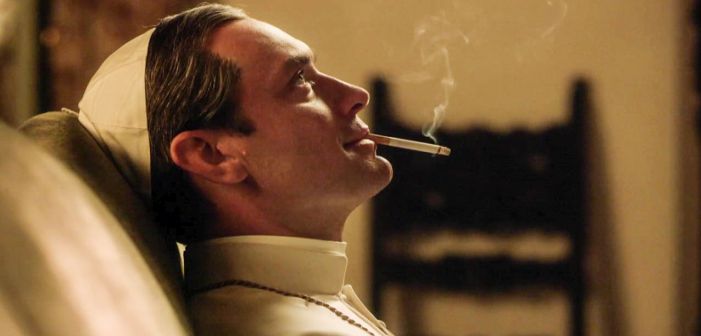When fiction, whether on the big or small screen, takes hold of the Church, with all its pomp and splendor, from Jude Law as a young pope to James Dean as a secular Christ, glamour is never far away. But it is never gratuitous: ecclesiastical grandeur, a sign of power, and its icons often conceal a vehement critique of the system…
Between two doors, in the soft light of the Roman morning, the Holy Father sheds his cassock. The pope reveals the body of an athletic forty-something, with muscular shoulders and firm buttocks. Currently aired on Canal+, the series “The Young Pope” is based on an apparently absurd premise: the Vatican sees the arrival at its head of a sovereign pontiff fit for magazine covers, with playboy looks and a pronounced taste for pontifical attire.
This fascinating figure, portrayed by Jude Law, will develop over the course of ten episodes. What if the “cool” appearance of Pius XIII, who fuels himself with Cherry Coke, is only meant to impose a fundamentalist doctrine? The beginning of the series, with its long tracking shots and close-ups on unsettling faces, weaves a familiar imagery. Revered Italian filmmaker Paolo Sorrentino, author of “The Great Beauty,” films the Church as one would film the mafia. Like the world of the underworld, the Vatican in cinema always hesitates between secrecy and grandeur.
A place of mysteries, fears… and assertion of power. It is in these terms that one should read the passion this fictional pope paradoxically has for the aesthetic attributes of the bishop of Rome: between a jeweled tiara overflowing with gemstones – which he demands the return of from the first episode – embroidered chasubles and slippers, this Pius XIII intends to become a holy image allowing a direct link with the sacred. An icon overthrowing Vatican II.
The sacerdotal glamour and the beauty of the successor of Saint Peter (“more beautiful than Jesus Christ himself,” Jude Law confesses with a smile as ironic as it is programmatic) are thus both an instrument of power and a kind of encyclical bringing the Church back to the time of the reconquest of minds, reflecting the Counter-Reformation aesthetic trend. When gold, velvet, and drapery were a response to the black and the rough cloth of Calvin…
By refusing contemporary media play and claiming pomp and grandeur, this television Pius XIII asserts his spiritual ambition and the advent of a new era for “the kingdom, power, and glory” of the Catholic and apostolic Church. In the process, Canal+ has been able to bet on the slightly scandalous glamour and allure of Jude Law for a massive communication campaign, of a magnitude previously reserved for Hollywood blockbusters. Because the playboy image spiced with pontifical regalia captivates viewers…
And this play of appearances and power has long fascinated filmmakers, for whom the Holy See can become the capital of all extravagances, and the Catholic religion, the pretext for all…


